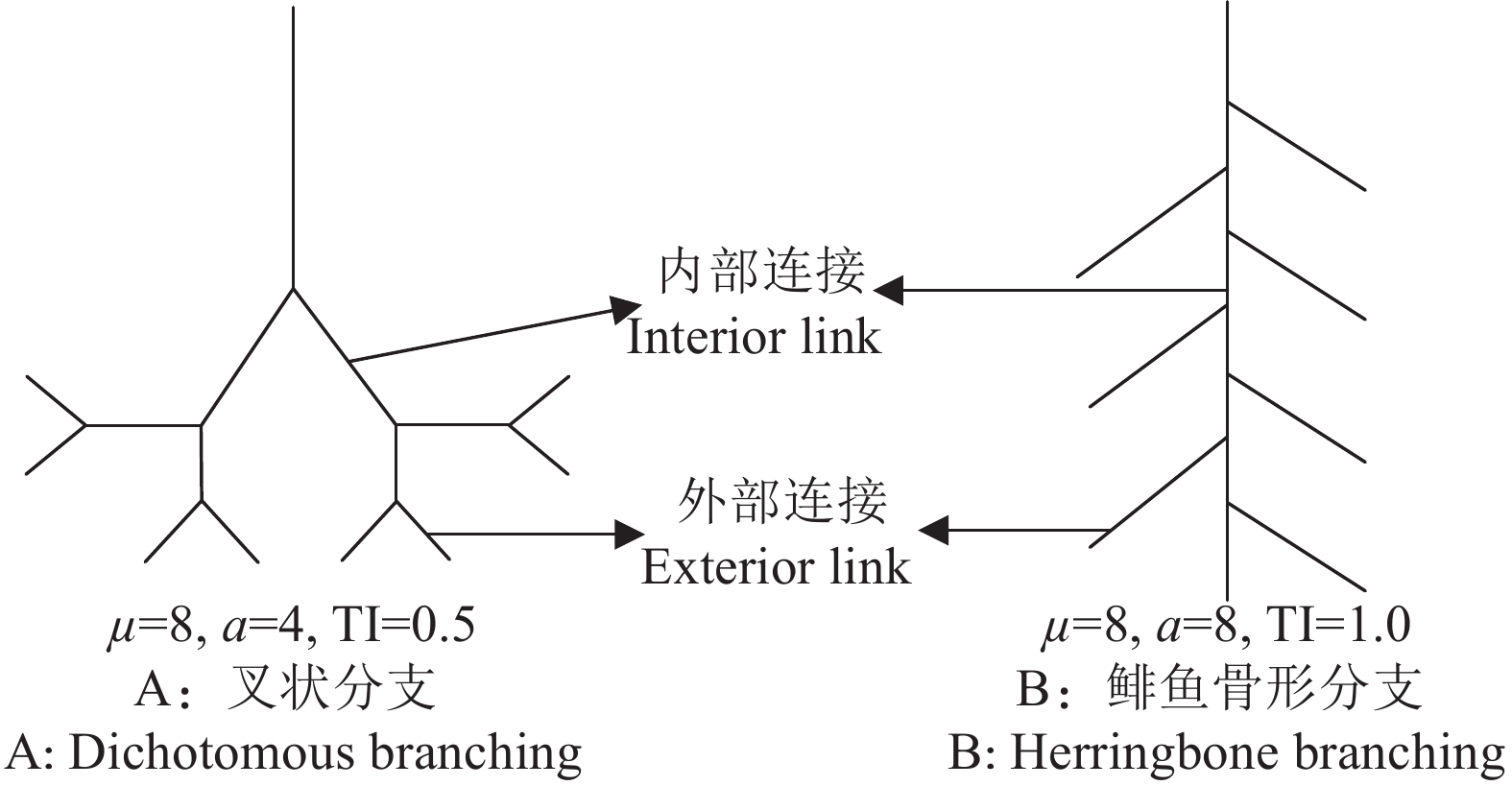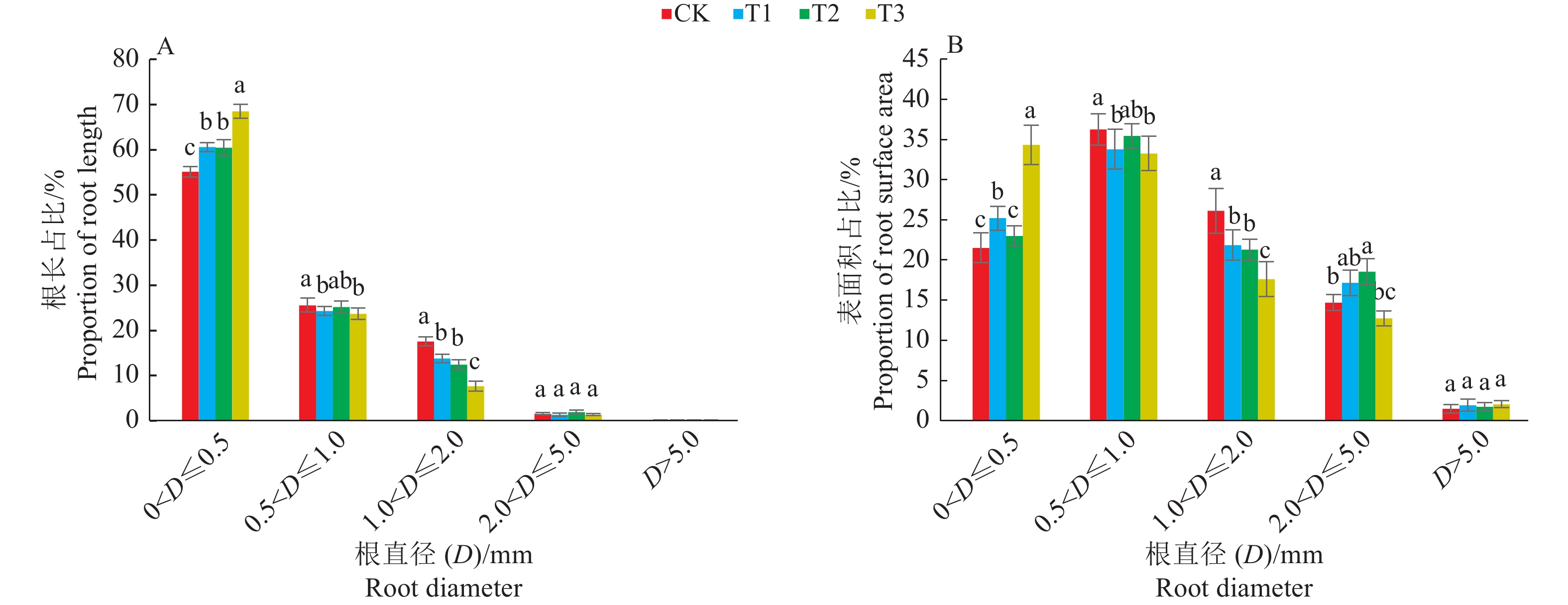Effects of maize straw and its biochar composite substrates on the architecture of maize roots
-
摘要:目的
研究玉米Zea mays L.秸秆及其生物炭对设施栽培中基质改良的价值,探明玉米根系构型及其对不同复配基质的响应。
方法采用盆栽试验,测定并分析了不同配比基质的理化性质和玉米地上部、根系生物量,采用WinRHIZO(Pro.2020a)根系分析系统分析计算玉米根系的形态以及分形、拓扑结构特征参数,采用SPSS软件分析地上部/根系生物量、根系形态特征与构型特征参数的相关性。
结果添加秸秆及其生物炭的各处理中,T3处理(蛭石、珍珠岩、玉米秸秆和玉米秸秆生物炭的添加量分别为22.4、22.4、22.4和44.8 dm3)的理化性质相较CK最为优化,总孔隙度和持水孔隙度分别达到81.02%和55.38%,可利用的速效氮、磷、钾含量均处在最优水平。T3处理根系的生物量和根长、根表面积、根体积3个主要形态特征参数均与其他处理差异显著,分别高于CK处理112.82%、79.89%、101.21%和102.53%。随着秸秆及其生物炭添加比例的增加,各处理根系分形维数逐渐增大,从CK的1.425增大至T3的1.514;拓扑指数逐渐减小,从CK的0.699减小至T3的0.627,T3处理的拓扑指数更接近0.5。玉米根系生物量和主要形态特征参数与分形维数、分形丰度呈极显著正相关,与拓扑指数呈极显著负相关。
结论添加秸秆及其生物炭可改善基质理化性质,为根系提供优质生长环境;环境对根系构型的可塑性较高,可以使玉米根系构型向更利于养分和水分利用的方向改变;根系构型性状可在一定程度上表征根系形态特征,也可作为指标来验证复合基质的栽培效果。
Abstract:ObjectiveTo study the value of maize straw and its biochar for substrate improvement in facility cultivation, and explore the response of root architecture of maize to different compound substrates.
MethodA pot experiment was carried out, the physicochemical properties of different ratios of substrates and the biomass of aboveground and roots of maize were measured and analyzed. The morphological, fractal and topological structure parameters of maize roots were analyzed and calculated by WinRHIZO (Pro.2020a) root analysis system. SPSS software was used to analyze the correlation of the aboveground/root biomass, root morphological parameters and architectural characteristics.
ResultAmong the treatments with addition of straw and its biochar, the physicochemical properties of T3 treatment (the addition volumes of vermiculite, perlite, maize straw and maize straw biochar were 22.4, 22.4, 22.4 and 44.8 dm3 respectively) were the most optimized compared to CK, with total porosity and water-holding porosity reaching 81.02% and 55.38% respectively, and the contents of available N, P, and K were all at the optimal level. In T3 treatment, the biomass of the root system, as well as the three main morphological parameters of root length, root surface area, and root volume, were significantly different from other treatments, which were 112.82%, 79.89%, 101.21%, and 102.53% higher than CK, respectively. With the increase of straw and its biochar addition ratio, the root fractal dimension of each treatment gradually increased, from 1.425 in CK to 1.514 in T3, and the topological index gradually decreased, from 0.699 in CK to 0.628 in T3, the topological index of T3 was closer to 0.5. The maize root biomass and main morphological parameters had very significantly positive correlations with fractal dimension and fractal abundance, and very significantly negative correlations with topological index.
ConclusionThe addition of straw and its biochar can effectively improve the physical and chemical properties of the substrate and provide a high-quality growth environment for the root system. The environment has a high plasticity for root architecture, the change of the physicochemical properties of the matrix can make the maize root architecture tend to change in a direction that is more conducive to nutrient and water utilization. The root architecture traits can characterize the morphological characteristics of the root system to a certain extent, and can also be used as an index to verify the cultivation effect of the composite substrates.
-
Keywords:
- Zea mays L. /
- Maize straw /
- Biochar /
- Root architecture /
- Fractal dimension /
- Topological index
-
-
图 3 不同处理玉米根系分形特征和拓扑结构的变化
各小图中,柱子上的不同小写字母表示不同处理间在P<0.05水平差异显著(Duncan’s法)
Figure 3. Changes in fractal characteristics and topological structure of maize roots in different treatments
In each figure, different lowercase letters on the columns indicate significant differences among different treatments at P<0.05 level (Duncan’s method)
图 4 不同径级根系的根长(A)和表面积(B)占比
各小图中,相同径级根系柱子上的不同小写字母表示不同处理间在P<0.05水平差异显著(Duncan’s法)
Figure 4. Proportion of root length (A) and surface area (B) for different diameter roots
In each figure, different lowercase on the columns of the same root diameter indicate significant differences among different treatments at P<0.05 level (Duncan’s method)
表 1 供试基质的基本理化性质
Table 1 Basic physical and chemical properties of the tested substrates
基质类型
Substrate type容重/
(g·cm−3)
Bulk densityw/(mg·kg−1) pH σ/
(μS·cm−1)
Electrical
conductivityw(有机质)/
(g·kg−1)
Organic matter
content碱解氮
Alkali N速效磷
Available P速效钾
Available K珍珠岩 Perlite 0.08 6.97 7.35 47.02 6.89 61 6.73 蛭石 Vermiculite 0.21 22.55 18.54 115.72 6.28 49 21.69 玉米秸秆
Maize straw0.19 194.54 126.18 1343.30 7.39 1 380 870.62 玉米秸秆生物炭
Maize straw biochar0.27 221.28 240.75 1 568.25 9.05 1 971 574.64 表 2 不同处理各栽培基质所占体积
Table 2 The volume of each cultivation substrate in different treatments
dm3 处理
Treatment蛭石
Vermiculite珍珠岩
Perlite玉米秸秆
Maize straw玉米秸秆生物炭
Maize straw biocharCK 56.0 56.0 0 0 T1 28.0 28.0 28.0 28.0 T2 22.4 22.4 44.8 22.4 T3 22.4 22.4 22.4 44.8 表 3 不同复配基质的基本物理性质1)
Table 3 Basic physical properties of different compound culture substrates
处理
Treatment容重/(g·cm−3)
Bulk density持水能力/%
Water holding capacity总孔隙度/%
Total porosity通气孔隙度/%
Aeration porosity持水孔隙度/%
Water-holding porosity水气比
Water-air ratioCK 0.15±0.01b 3.67±0.23b 69.28±0.36c 29.22±0.11a 40.06±0.84c 1.37±0.01b T1 0.20±0.01a 3.73±0.41a 74.24±0.84b 23.72±0.23c 50.52±1.21b 2.12±0.11a T2 0.21±0.01a 3.61±0.81bc 64.02±0.41c 28.64±0.29a 35.38±0.21d 1.24±0.02b T3 0.22±0.02a 3.52±0.22c 81.02±0.71a 25.64±0.31b 55.38±0.92a 2.16±0.03a 1)同列数据后的不同小写字母表示不同处理间差异显著(P < 0.05,Duncan’s法)
1) Different lowercase letters in the same column indicate significant differences among different treatments (P < 0.05, Duncan’s method)表 4 不同复配基质的基本化学性质1)
Table 4 Basic chemical properties of different compound culture substrates
处理
Treatmentw(mg·kg−1) pH σ/(μS·cm−1)
Electrical conductivityw(有机质)/(g·kg−1)
Organic matter
content碱解氮
Alkali N速效磷
Available P速效钾
Available KCK 15.12±2.12c 13.94±0.94c 81.36±2.41c 6.68±0.74c 79±13c 12.21±0.45c T1 133.77±7.29b 107.74±1.78b 874.00±19.00b 7.59±0.58b 1812±43b 397.00±16.00b T2 215.48±3.69a 201.69±5.41a 1341.00±34.00a 7.46±0.19b 1975±26ab 721.00±27.00a T3 207.96±5.24a 184.52±3.42a 1375.00±31.00a 8.05±0.91a 2163±81a 689.00±32.00a 1)同列数据后的不同小写字母表示不同处理间差异显著(P < 0.05,Duncan’s法)
1) Different lowercase letters in the same column indicate significant differences among different treatments (P < 0.05, Duncan’s method)表 5 不同处理玉米地上部、根系生物量和根系形态特征参数1)
Table 5 Aboveground and root biomass, root morphological parameters of maize in different treatments
处理
Treatment单株地上部生物量/g
Aboveground
biomass per plant单株根系生物量/g
Root biomass
per plant根长/cm
Root
length根表面积/cm2
Root surface
area根平均直径/mm
Root average
diameter根体积/cm3
Root
volumeCK 1.93±0.60c 0.39±0.11c 780.45±81.75d 131.98±24.12d 0.69±0.06a 1.99±0.71c T1 3.69±1.30b 0.49±0.09c 976.57±70.17c 165.25±13.59c 0.58±0.07b 2.23±0.28c T2 4.19±1.31b 0.73±0.21b 1 213.20±58.27b 221.49±24.16b 0.55±0.09b 3.26±0.74b T3 4.51±1.28a 0.83±0.20a 1 403.95±126.36a 265.55±40.22a 0.54±0.03b 4.03±0.92a 处理
Treatment根尖数
Tip
number分支数
Fork
number交叉数
Crossing
number平均分支角/(°)
Average branching
angle根尖密度/(cm−1)
Root tip
intensity分支密度/(cm−1)
Root fork
intensityCK 1 934.29±166.72c 2 139.71±433.36c 222.86±49.52c 51.73±0.86b 2.22±0.52b 2.62±0.35b T1 2 753.71±513.56b 2 649.43±373.49b 285.14±69.92b 50.91±0.92b 2.31±0.24b 2.71±0.33b T2 2 701.43±677.89b 4 067.71±569.90a 423.43±92.87a 53.32±1.65a 2.40±0.18b 3.35±0.37a T3 3 232.00±334.22a 4 468.00±930.85a 441.14±59.89a 52.54±1.10a 2.83±0.59a 3.16±0.38a 1)同列数据后的不同小写字母表示不同处理间差异显著(P < 0.05,Duncan’s法)
1) Different lowercase letters in the same column indicate significant differences among different treatments (P < 0.05, Duncan’s method)表 6 玉米地上部和根系生物量、根系的形态特征与分形特征、拓扑结构的相关性1)
Table 6 Correlation of aboveground/root biomass, morphological characteristics and fractal characteristic, topological structure of roots in maize
特征
Characteristic分形维数
Fractal dimension分形丰度
Fractal abundance拓扑指数
Topology index平均连接长度
Average link length地上部生物量 Aboveground biomass 0.407* 0.603** −0.460* −0.368 根系生物量 Root biomass 0.771** 0.812** −0.626** −0.448* 根长 Root length 0.720** 0.970** −0.735** −0.591** 表面积 Surface area 0.806** 0.945** −0.705** −0.547** 平均直径 Average diameter 0.326 0.469* −0.286 −0.138 根体积 Root volume 0.798** 0.856** −0.638** −0.484** 根尖数 Tip number 0.310 0.697** −0.354 −0.349 分支数 Fork number 0.731** 0.878** −0.719** −0.653** 交叉数 Crossing number 0.533** 0.743** −0.667** −0.554** 平均分支角 Average branching angle 0.313 0.334 −0.533** −0.434* 根尖密度 Root tip intensity 0.476* 0.231 −0.413* −0.217 分支密度 Root fork intensity 0.617** 0.608** −0.542** −0.602** 分形维数 Fractal dimension 1.000 0.717** −0.585** −0.430* 分形丰度 Fractal abundance 1.000 −0.683** −0.517** 拓扑指数 Topology index 1.000 0.610** 平均连接长度 Average link length 1.000 1) “*”和“**”分别表示在P<0.05和P<0.01水平显著相关(Pearson法)
1) “*” and “**” represent significant correlations at P<0.05 and P<0.01 levels, respectively (Pearson method) -
[1] 宋洁, 李志洪, 赵小军, 等. 秸秆还田对土壤微团聚体特征的影响[J]. 水土保持学报, 2018, 32(5): 116-120. doi: 10.13870/j.cnki.stbcxb.2018.05.019 [2] 范如芹, 罗佳, 严少华, 等. 农作物秸秆基质化利用技术研究进展[J]. 生态与农村环境学报, 2016, 32(3): 410-416. doi: 10.11934/j.issn.1673-4831.2016.03.012 [3] 朱丽, 陈晓东, 乔玉山, 等. 不同配比基质对草莓母苗生长和抽生匍匐茎的影响[J]. 江西农业大学学报, 2021, 43(3): 547-554. doi: 10.13836/j.jjau.2021061 [4] 张新宇. 不同复配基质对草莓植株生长的果实品质的影响[D]. 合肥: 安徽农业大学, 2021. [5] 张海晶, 王少杰, 田春杰, 等. 玉米秸秆及其生物炭对东北黑土溶解有机质特性的影响[J]. 水土保持学报, 2021, 35(2): 243-250. doi: 10.13870/j.cnki.stbcxb.2021.02.032 [6] KAVITHA B, REDDY P V L, KIM B, et al. Benefits and limitations of biochar amendment in agricultural soils: A review[J]. Journal of Environmental Management, 2018, 227: 146-154.
[7] 陈庆飞, 石岩, 刘玉学, 等. 生物炭替代泥炭栽培基质对铁皮石斛生长的影响[J]. 中国农学通报, 2015, 31(13): 30-35. doi: 10.11924/j.issn.1000-6850.casb14120043 [8] 文中华, 刘喜雨, 孟军, 等. 生物炭和腐熟秸秆组配基质对水稻幼苗生长的影响[J]. 沈阳农业大学学报, 2020, 51(1): 10-17. [9] 孙守如, 杨秋生, 董晓宇, 等. 玉米秸有机栽培基质矿质营养及理化性质分析[J]. 农业工程学报, 2008, 24(6): 41-44. doi: 10.3321/j.issn:1002-6819.2008.06.008 [10] 刘超杰, 郭世荣, 束胜, 等. 醋糟基质粉碎程度对辣椒幼苗生长和光合能力的影响[J]. 农业工程学报, 2010, 26(1): 330-334. doi: 10.3969/j.issn.1002-6819.2010.01.059 [11] 刘振国. 玉米秸秆不同配比基质对黄瓜生长发育的影响[D]. 郑州: 河南农业大学, 2009. [12] 刘梅, 吴广俊, 路笃旭, 等. 不同年代玉米品种氮素利用效率与其根系特征的关系[J]. 植物营养与肥料学报, 2017, 23(1): 71-82. doi: 10.11674/zwyf.16158 [13] MCCORMACK M L, GUO D L, IVERSEN C M, et al. Building a better foundation: Improving root-trait measurements to understand and model plant and ecosystem processes[J]. The New Phytologist, 2017, 215(1): 27-37. doi: 10.1111/nph.14459
[14] MALAMY J E. Intrinsic and environmental response pathways that regulate root system architecture[J]. Plant Cell and Environment, 2005, 28(1): 67-77. doi: 10.1111/j.1365-3040.2005.01306.x
[15] 单立山, 李毅, 任伟, 等. 河西走廊中部两种荒漠植物根系构型特征[J]. 应用生态学报, 2013, 24(1): 25-31. doi: 10.13287/j.1001-9332.2013.0152 [16] FITTER A H. The topology and geometry of plant root systems: Influence of watering rate on root system topology in Trifolium pratense[J]. Annals of Botany, 1986, 58(1): 91-101. doi: 10.1093/oxfordjournals.aob.a087191
[17] LYNCH J. Root architecture and plant productivity[J]. Plant Physiology, 1995, 109(1): 7-13. doi: 10.1104/pp.109.1.7
[18] 杨培岭, 罗远培. 冬小麦根系形态的分形特征[J]. 科学通报, 1994, 39(20): 1911-1913. doi: 10.3321/j.issn:0023-074X.1994.20.026 [19] DANNOWSKI M, BLOCK A. Fractal geometry and root system structures of heterogeneous plant communities[J]. Plant and Soil, 2005, 272(1/2): 61-76.
[20] GUO S, LIU Z J, ZHOU Z J, et al. Root system architecture differences of maize cultivars affect yield and nitrogen accumulation in Southwest China[J]. Agriculture, 2022, 12(2): 209. doi: 10.3390/agriculture12020209.
[21] 漆栋良, 胡田田, 吴雪, 等. 灌水方式对玉米根系生长及产量和水分利用的影响[J]. 西北农业学报, 2014, 23(8): 73-78. doi: 10.7606/j.issn.1004-1389.2014.08.012 [22] 郭世荣. 无土栽培学[M]. 北京: 中国农业出版社, 2011. [23] 鲍士旦. 土壤农化分析[M]. 北京: 中国农业出版社, 2000. [24] 汪飞, 罗学刚, 赵健, 等. 松针和椰糠无土栽培基质理化性质比较研究[J]. 中国农学通报, 2016, 32(22): 164-169. doi: 10.11924/j.issn.1000-6850.casb16040143 [25] 刘佳, 项文化, 徐晓, 等. 湖南会同5个亚热带树种的细根构型及功能特征分析[J]. 植物生态学报, 2010, 34(8): 938-945. doi: 10.3773/j.issn.1005-264x.2010.08.006 [26] 李金航, 周玫, 朱济友, 等. 黄栌幼苗根系构型对土壤养分胁迫环境的适应性研究[J]. 北京林业大学学报, 2020, 42(3): 65-77. doi: 10.12171/j.1000-1522.20190218 [27] 任杰, 赵成章, 赵夏纬, 等. 金塔绿洲荒漠交错带沙蓬根系分形特征[J]. 生态学报, 2020, 40(15): 5298-5305. [28] KETIPEARACHCHI K W, TATSUMI J. Local fractal dimensions and multifractal analysis of the root system of legumes[J]. Plant Production Science, 2000, 3(3): 289-295. doi: 10.1626/pps.3.289
[29] 马雄忠, 王新平. 阿拉善高原2种荒漠植物根系构型及生态适应性特征[J]. 生态学报, 2020, 40(17): 6001-6008. [30] BEIDLER K V, TAYLOR B N, STRAND A E, et al. Changes in root architecture under elevated concentrations of CO2 and nitrogen reflect alternate soil exploration strategies[J]. The New Phytologist, 2015, 205(3): 1153-1163. doi: 10.1111/nph.13123
[31] 王宇欣, 孙倩倩, 王平智, 等. 玉米秸秆复配基质对黄瓜幼苗生长发育的影响[J]. 农业机械学报, 2018, 49(7): 286-295. doi: 10.6041/j.issn.1000-1298.2018.07.034 [32] 连兆煌. 无土栽培原理与技术[M]. 北京: 中国农业出版社, 1994: 58-59. [33] PRESTERL T, SEITZ G, LANDBECK M, et al. Improving nitrogen-use efficiency in European maize: Estimation of quantitative genetic parameters[J]. Crop Science, 2003, 43(4): 1259-1265. doi: 10.2135/cropsci2003.1259
[34] 张硕, 余宏军, 蒋卫杰. 发酵玉米芯或甘蔗渣基质的黄瓜育苗效果[J]. 农业工程学报, 2015, 31(11): 236-242. doi: 10.11975/j.issn.1002-6819.2015.11.034 [35] 程效义, 孟军, 黄玉威, 等. 生物炭对玉米根系生长和氮素吸收及产量的影响[J]. 沈阳农业大学学报, 2016, 47(2): 218-223. [36] 范龙, 吴啸鹏, 黄敏, 等. 生物炭施用对水稻育秧土理化特性和秧苗素质的影响[J]. 华南农业大学学报, 2018, 39(1): 40-44. doi: 10.7671/j.issn.1001-411X.2018.01.007 [37] 蒋健, 王宏伟, 刘国玲, 等. 生物炭对玉米根系特性及产量的影响[J]. 玉米科学, 2015, 23(4): 62-66. doi: 10.13597/j.cnki.maize.science.20150412 [38] 杨小林, 张希明, 李义玲, 等. 基于分形理论的塔克拉玛干沙漠腹地自然植物根系构型特征分析[J]. 干旱区资源与环境, 2015, 29(8): 145-150. doi: 10.13448/j.cnki.jalre.2015.272 [39] 杨小林, 张希明, 李义玲, 等. 塔克拉玛干沙漠腹地几种植物根系分形特征[J]. 干旱区地理, 2009, 32(2): 249-254. [40] 闫励, 杨方社, 李怀恩, 等. 砒砂岩区不同立地下沙棘根系分形特征[J]. 干旱区研究, 2019, 36(2): 467-473. doi: 10.13866/j.azr.2019.02.24 [41] BERNTSON G M. Topological scaling and plant root system architecture: Developmental and functional hierarchies[J]. The New Phytologist, 1997, 135(4): 621-634. doi: 10.1046/j.1469-8137.1997.00687.x
[42] 吕爽, 张现慧, 张楠, 等. 胡杨幼苗根系生长与构型对土壤水分的响应[J]. 西北植物学报, 2015, 35(5): 1005-1012. doi: 10.7606/j.issn.1000-4025.2015.05.1005 [43] 张立芸, 段青松, 李永梅. 坡耕地山原红壤大豆根系构型及根土复合体力学特性[J]. 中国生态农业学报(中英文), 2022, 30(9): 1464-1476. doi: 10.12357/cjea.20220003




 下载:
下载:



